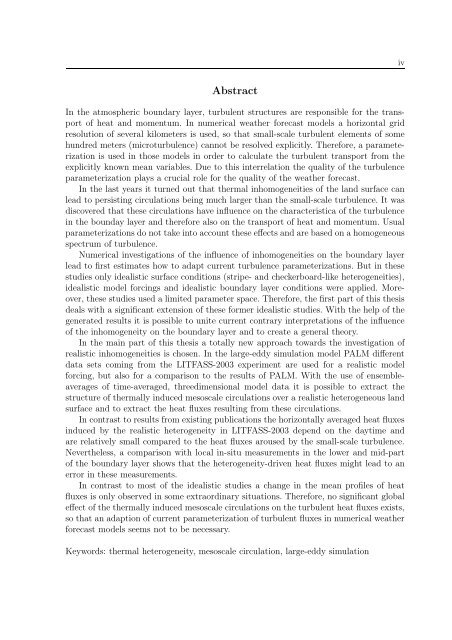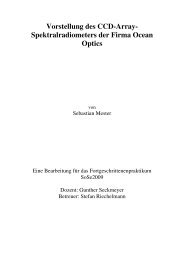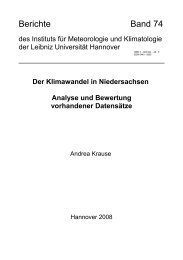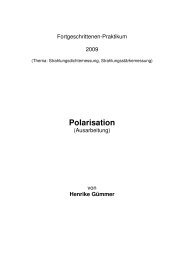PDF (18,7 MB) - Institut für Meteorologie und Klimatologie an der ...
PDF (18,7 MB) - Institut für Meteorologie und Klimatologie an der ...
PDF (18,7 MB) - Institut für Meteorologie und Klimatologie an der ...
Sie wollen auch ein ePaper? Erhöhen Sie die Reichweite Ihrer Titel.
YUMPU macht aus Druck-PDFs automatisch weboptimierte ePaper, die Google liebt.
Abstract<br />
In the atmospheric bo<strong>und</strong>ary layer, turbulent structures are responsible for the tr<strong>an</strong>sport<br />
of heat <strong>an</strong>d momentum. In numerical weather forecast models a horizontal grid<br />
resolution of several kilometers is used, so that small-scale turbulent elements of some<br />
h<strong>und</strong>red meters (microturbulence) c<strong>an</strong>not be resolved explicitly. Therefore, a parameterization<br />
is used in those models in or<strong>der</strong> to calculate the turbulent tr<strong>an</strong>sport from the<br />
explicitly known me<strong>an</strong> variables. Due to this interrelation the quality of the turbulence<br />
parameterization plays a crucial role for the quality of the weather forecast.<br />
In the last years it turned out that thermal inhomogeneities of the l<strong>an</strong>d surface c<strong>an</strong><br />
lead to persisting circulations being much larger th<strong>an</strong> the small-scale turbulence. It was<br />
discovered that these circulations have influence on the characteristica of the turbulence<br />
in the bo<strong>und</strong>ay layer <strong>an</strong>d therefore also on the tr<strong>an</strong>sport of heat <strong>an</strong>d momentum. Usual<br />
parameterizations do not take into account these effects <strong>an</strong>d are based on a homogeneous<br />
spectrum of turbulence.<br />
Numerical investigations of the influence of inhomogeneities on the bo<strong>und</strong>ary layer<br />
lead to first estimates how to adapt current turbulence parameterizations. But in these<br />
studies only idealistic surface conditions (stripe- <strong>an</strong>d checkerboard-like heterogeneities),<br />
idealistic model forcings <strong>an</strong>d idealistic bo<strong>und</strong>ary layer conditions were applied. Moreover,<br />
these studies used a limited parameter space. Therefore, the first part of this thesis<br />
deals with a signific<strong>an</strong>t extension of these former idealistic studies. With the help of the<br />
generated results it is possible to unite current contrary interpretations of the influence<br />
of the inhomogeneity on the bo<strong>und</strong>ary layer <strong>an</strong>d to create a general theory.<br />
In the main part of this thesis a totally new approach towards the investigation of<br />
realistic inhomogeneities is chosen. In the large-eddy simulation model PALM different<br />
data sets coming from the LITFASS-2003 experiment are used for a realistic model<br />
forcing, but also for a comparison to the results of PALM. With the use of ensembleaverages<br />
of time-averaged, threedimensional model data it is possible to extract the<br />
structure of thermally induced mesoscale circulations over a realistic heterogeneous l<strong>an</strong>d<br />
surface <strong>an</strong>d to extract the heat fluxes resulting from these circulations.<br />
In contrast to results from existing publications the horizontally averaged heat fluxes<br />
induced by the realistic heterogeneity in LITFASS-2003 depend on the daytime <strong>an</strong>d<br />
are relatively small compared to the heat fluxes aroused by the small-scale turbulence.<br />
Nevertheless, a comparison with local in-situ measurements in the lower <strong>an</strong>d mid-part<br />
of the bo<strong>und</strong>ary layer shows that the heterogeneity-driven heat fluxes might lead to <strong>an</strong><br />
error in these measurements.<br />
In contrast to most of the idealistic studies a ch<strong>an</strong>ge in the me<strong>an</strong> profiles of heat<br />
fluxes is only observed in some extraordinary situations. Therefore, no signific<strong>an</strong>t global<br />
effect of the thermally induced mesoscale circulations on the turbulent heat fluxes exists,<br />
so that <strong>an</strong> adaption of current parameterization of turbulent fluxes in numerical weather<br />
forecast models seems not to be necessary.<br />
Keywords: thermal heterogeneity, mesoscale circulation, large-eddy simulation<br />
iv





